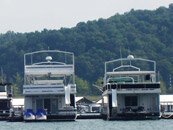Ready to learn some more nautical-speak? Let’s say you have a tire swing in the back yard—an old tire hanging on a rope. Now, take the rope off the swing, and walk down to the dock. The moment you step from the dock to the boat, that rope in your hand is now a line, in boating terminology. The lines you use to tie your boat to a dock are called, appropriately enough, docklines.
Lineology
When selecting docklines for your boat, there are some particulars that you want to look for:
Material
Nylon’s the first choice for most pleasure boat docklines, because of its inherent strength and the fact that it’ll stretch a little bit as your boat rocks gently to and fro at the dock.
Construction
You’re going to find that nylon docklines are usually made of either three-strand or braided construction. What’s the difference? Three-strand docklines tend to stretch or give quite a bit, and are abrasion-resistant.
3-strand dockline detail
Braided nylon docklines are stronger, are available in lots of cool colors to match your boat, and seem to feel more substantial in one’s hands (a very subjective thing, but important). You’ll pay more for braided lines, however, in the long run; they’ll likely outlive their three-strand counterparts.
Double-braided dockline detail
Size
Docklines can be had in a variety of diameters and lengths—so what lines do you need for your personal pride and joy? The answer depends on how big your boat is.
If your boat is under 27’ length overall (LOA), your best bet would be 3/8” diameter docklines, about 2/3 as long as the boat for bow and stern lines, and lines the same length as your vessel for spring lines. Recommended dockline diameter and length increases proportionately with boat size.
Line Protection
You’ll need to protect your docklines from chafing (rubbing against the boat and/or dock) if you keep your boat tied up for any appreciable length of time. There are dozens of anti-chafe products on the market for nearly every application; your marine retailer can offer you personalized advice on this topic.
Chafe guard
Things That Go Bump at the Dock
Now that you’ve got the right docklines, the next item on the agenda is preventing your boat from beating itself to death at the dock, and vice-versa.
We use special cushions, called fenders, placed strategically along the side of the boat, to isolate it from the dock. Fenders are often made of soft inflatable plastic, or closed-cell foam, and come in all kinds of shapes, sizes, and colors, so you shouldn’t have a problem obtaining the right type of fenders for your situation.
Inflatable fenders
Advice
Don’t skimp when it comes to docklines and fenders; a boat is a substantial investment and deserves good equipment.
Regarding fenders, it’s a good idea to hang them over the side while you’re idling up to the dock, but please, stow the fenders (stow: put something away where it belongs) before hitting the open water.
Nothing says “novice” more than someone cruising along, oblivious to the fenders flopping in the breeze, like so much waterborne laundry.

